Geometry construction¶
Many PostGIS functions work with geometries as they are to perform some interrogation or analysis. For example:
- ST_Length, ST_Area—Analyses of the objects
- ST_AsText, ST_AsGML—Serializations of the objects
- ST_RingN—Parts of the object
- ST_Contains, ST_Intersects-True/false tests
In addition, PostGIS also provides a number of geometry constructing functions that take geometries as inputs and output new geometries.
Centroid and PointOnSurface¶
A common requirement when composing a spatial query is to replace a polygon feature with a point representation of the feature. This is useful for spatial joins because using ST_Intersects on two polygon layers often results in double-counting—a polygon on a boundary will intersect an object on both sides. Replacing the polygon with a point forces it to be on one side or the other, not both. PostGIS provides the following two functions to return a point at the center of an input geometry:
ST_Centroid(geometry)—Returns a point that is at the center of mass of the input geometry
Note
Although this simple calculation is very fast, be aware the returned point is not necessarily inside the feature itself. If the input feature has a convexity (imagine the letter ‘C’) the returned centroid might not be in the interior of the feature.
ST_PointOnSurface(geometry)—Returns a point that is guaranteed to be inside the input geometry
Note
This operation is computationally more expensive than the ST_Centroid operation.
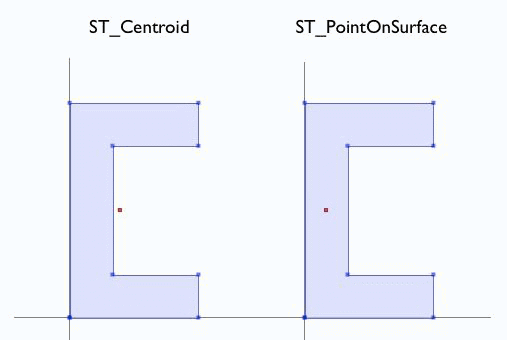
ST_Centroid and ST_PointOnSurface
Buffer¶
Creating a buffer, or area of specified distance, around a particular feature is a common task in many GIS workflows. ST_Buffer(geometry,distance) accepts a buffer distance and geometry type and outputs a polygon with a boundary the buffer distance away from the input geometry.
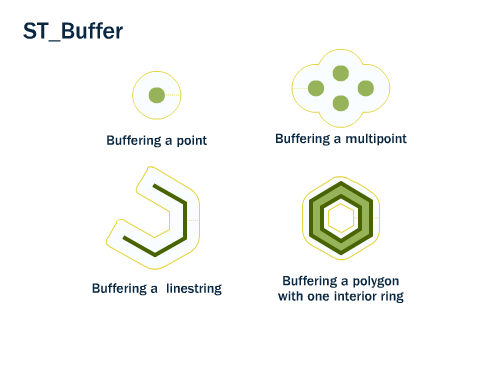
ST_Buffer
For example, if the US Park Service wanted to enforce a marine traffic zone around Liberty Island in New York harbor, they could delineate the zone by generating a 500 meter buffer polygon around the island.
CREATE TABLE liberty_island_zone AS
SELECT ST_Buffer(the_geom,500) AS the_geom
FROM nyc_census_blocks
WHERE blkid = '360610001009000';
SELECT Populate_Geometry_Columns();
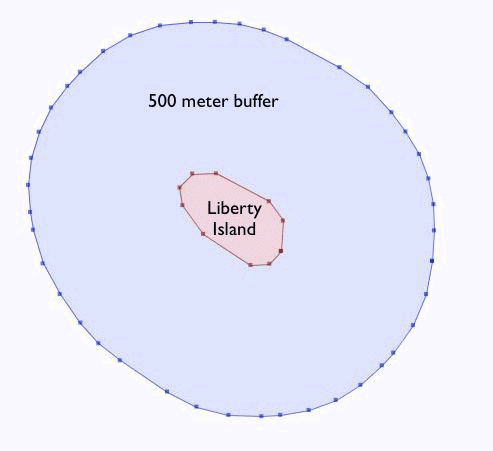
Positive buffer
The ST_Buffer function also accepts negative distances and builds inscribed polygons within polygonal inputs. Input lines and points will generate an empty return.
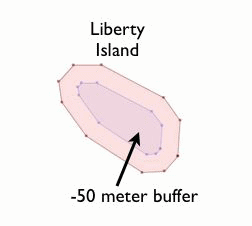
Negative buffer
Intersection and Union¶
Intersection is another common GIS operation, which creates a new coverage by calculating the intersection of two superimposed polygons. The ST_Intersection(geometry A, geometry B) function returns the spatial area, line, or point that both input geometries have in common. If the geometries are disjoint, the function returns an empty geometry.
SELECT ST_AsText(ST_Intersection(
ST_Buffer('POINT(0 0)', 2),
ST_Buffer('POINT(3 0)', 2)
));
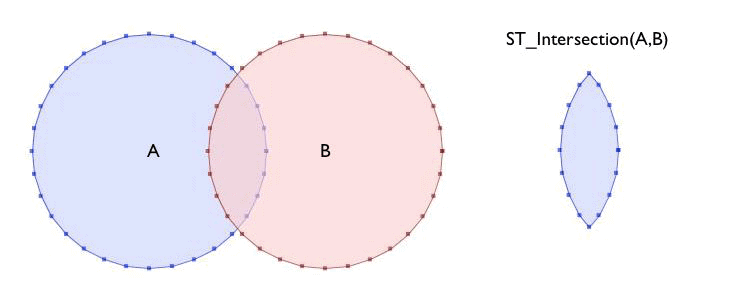
ST_Intersection
The ST_Union does the reverse; it takes input geometries and removes common lines. There are two forms of the ST_Union function:
- ST_Union(geometry, geometry)—A two-argument version that takes in two geometries and returns the merged union. For example, the two-circle example from the previous section looks like the following when the intersection is replaced with a union.
SELECT ST_AsText(ST_Union(
ST_Buffer('POINT(0 0)', 2),
ST_Buffer('POINT(3 0)', 2)
));

ST_Union
- ST_Union([geometry])—An aggregate version that takes in a set of geometries and returns the merged geometry for the entire group. ST_Union can be used with the GROUP BY SQL statement to create merged subsets of basic geometries.
Census geography provides a good example of ST_Union aggregation, with larger geographies constructed from smaller ones. Census tracts map can be created by merging the blocks that form each tract. Alternatively, merging blocks that fall within each county can produce a county map.
To carry out the merge, note that the unique key blkid actually embeds information about the higher level geographies. The following example illustrates the parts of the key for Liberty Island in New York county:
360610001009000 = 36 061 00100 9000
36 = State of New York
061 = New York County (Manhattan)
000100 = Census Tract
9 = Census Block Group
000 = Census Block
A county map can be produced by merging all geometries that share the same first 5 digits of their blkid.
CREATE TABLE nyc_census_counties AS
SELECT
ST_Union(the_geom) AS the_geom,
SubStr(blkid,1,5) AS countyid
FROM nyc_census_blocks
GROUP BY countyid;
SELECT Populate_Geometry_Columns();
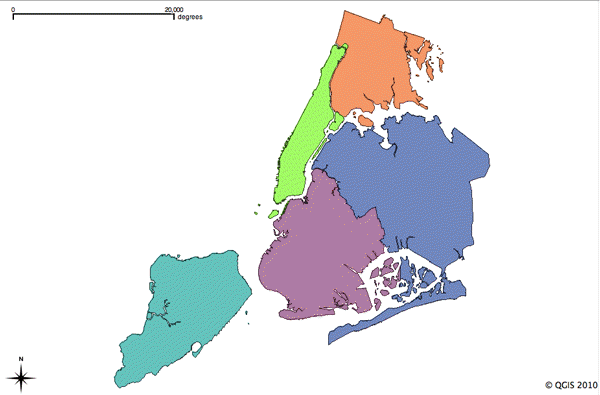
Union applied to census blocks to create county polygons
An area test will confirm the union operation did not lose any geometry. First, calculate the area of each individual census block, and sum those areas grouping by census county id.
SELECT SubStr(blkid,1,5) AS countyid, Sum(ST_Area(the_geom)) AS area
FROM nyc_census_blocks
GROUP BY countyid;
countyid | area
----------+------------------
36005 | 109807439.720947
36047 | 184906575.839355
36061 | 58973521.6225586
36081 | 283764734.207275
36085 | 149806077.958252
Finally, calculating the area of each of the new county polygons from the county table should return the same answer:
SELECT countyid, ST_Area(the_geom) AS area
FROM nyc_census_counties;
countyid | area
----------+------------------
36005 | 109807439.720947
36047 | 184906575.839355
36061 | 58973521.6225586
36081 | 283764734.207275
36085 | 149806077.958252
For more information about geometry functions in PostGIS, please refer to PostGIS Reference.